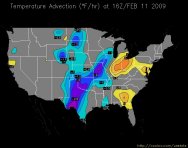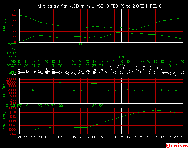 << Back
<< Back

Weather Station Assignment #4:
In the fourth Weather Station Assignment, I worked with temperature advection maps. The assignment was to find a part of the country that was experiencing cold-air advection. I also had to make sure that the skies were partly cloudly to mostly sunny over the city I picked. This was to see the outcome of whether cold-air advection or solar heating was the dominant force in controlling daytime air temperature that day. After I picked a location, then a city within that particular location, I had to get the meteogram for the city in order to see which of the two forces had been influencing the daytime temperature the most.
The city I chose for the assignment was Lubbock, Texas. Here is my post as well as the temperature advection map, and meteogram from Lubbock.

16Z 02/11/09
Lubbock, Texas (KLBB)
At 16Z or 10 am CST, Lubbock was experiencing cold-air advection at the rate of -2 °F an hour. The air temperature at this time was 45°F. However, since the skies were clear over the area, the cold-air advection ended up having little effect on the temperature due to the solar heating of the sun. The temperature continued to rise over the next few hours at the rate of about 3°F per hour and by 19Z or 1 pm CST, the city’s temperature was at 55°F. Since the temperature was rising by 3°F per hour while there was cold-air advection taking place at the rate of -2°F per hour, the heating from the sun was able to counteract the effects of the cold-air convection completely.

The temperature advection map.

The meteogram for Lubbock.

Reflection:
I found this weather station assignment to be quite interesting and have learned a lot from studying temperature advection. Especially since I have often seen the effects of some form of temperature advection on our home thermometer. There would be times when the temperature would rise at night, or else fall during the day and I would always wonder why. So it was interesting to find out the cause for it and what it was called. Now the next time I see the temperature rising or falling when it should be doing just the opposite, I'll know what might be the possible reason for it.



